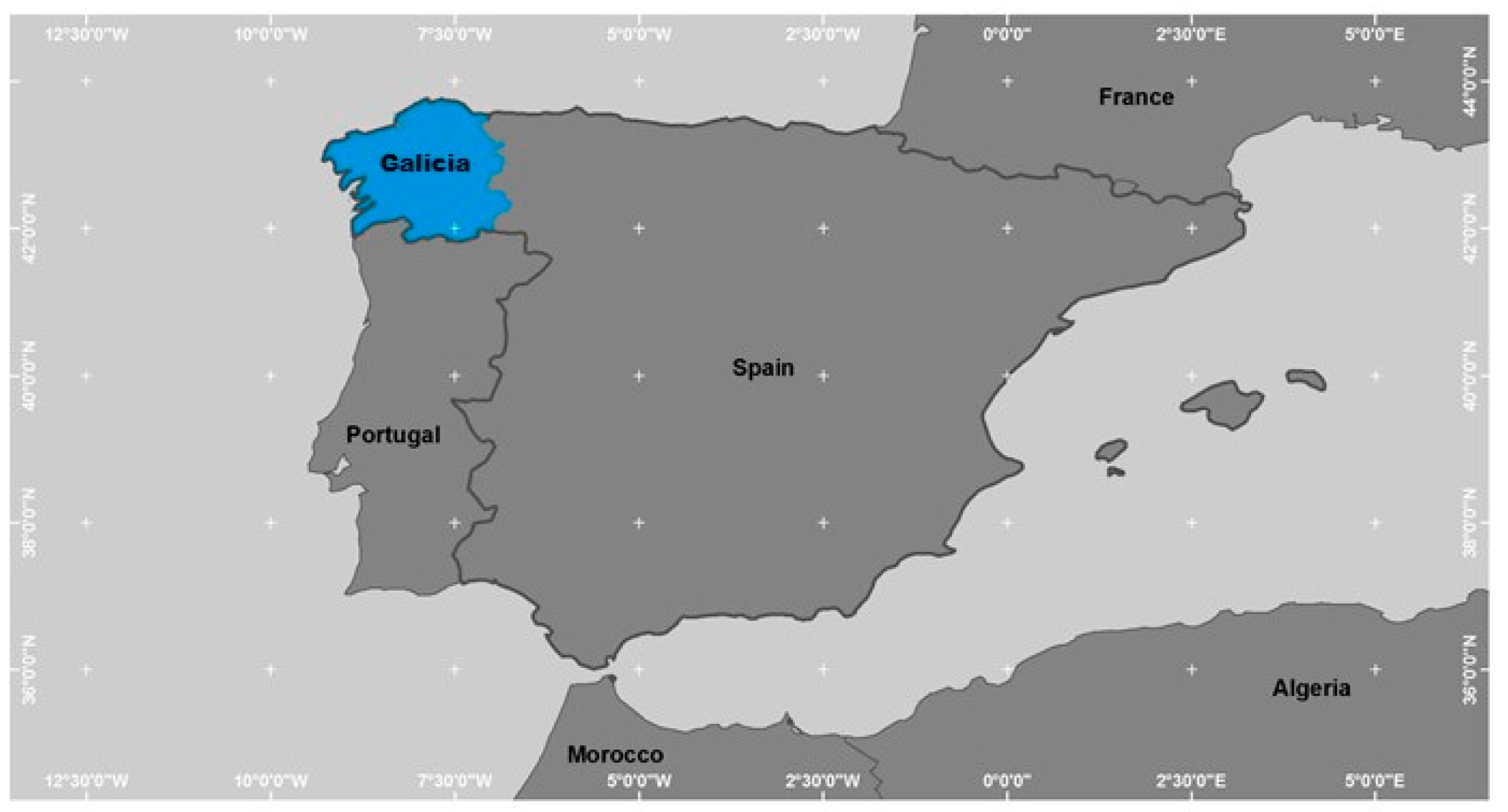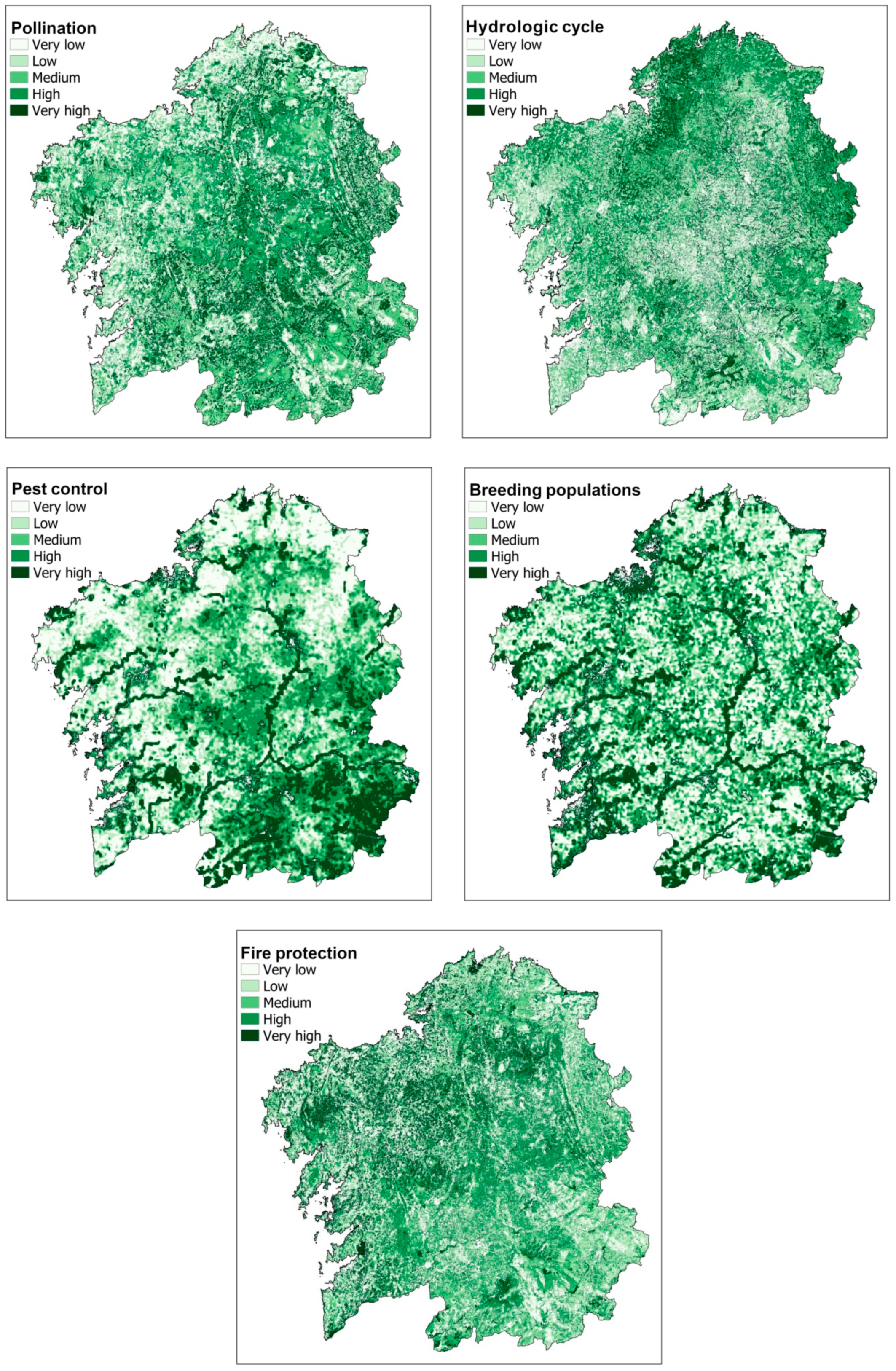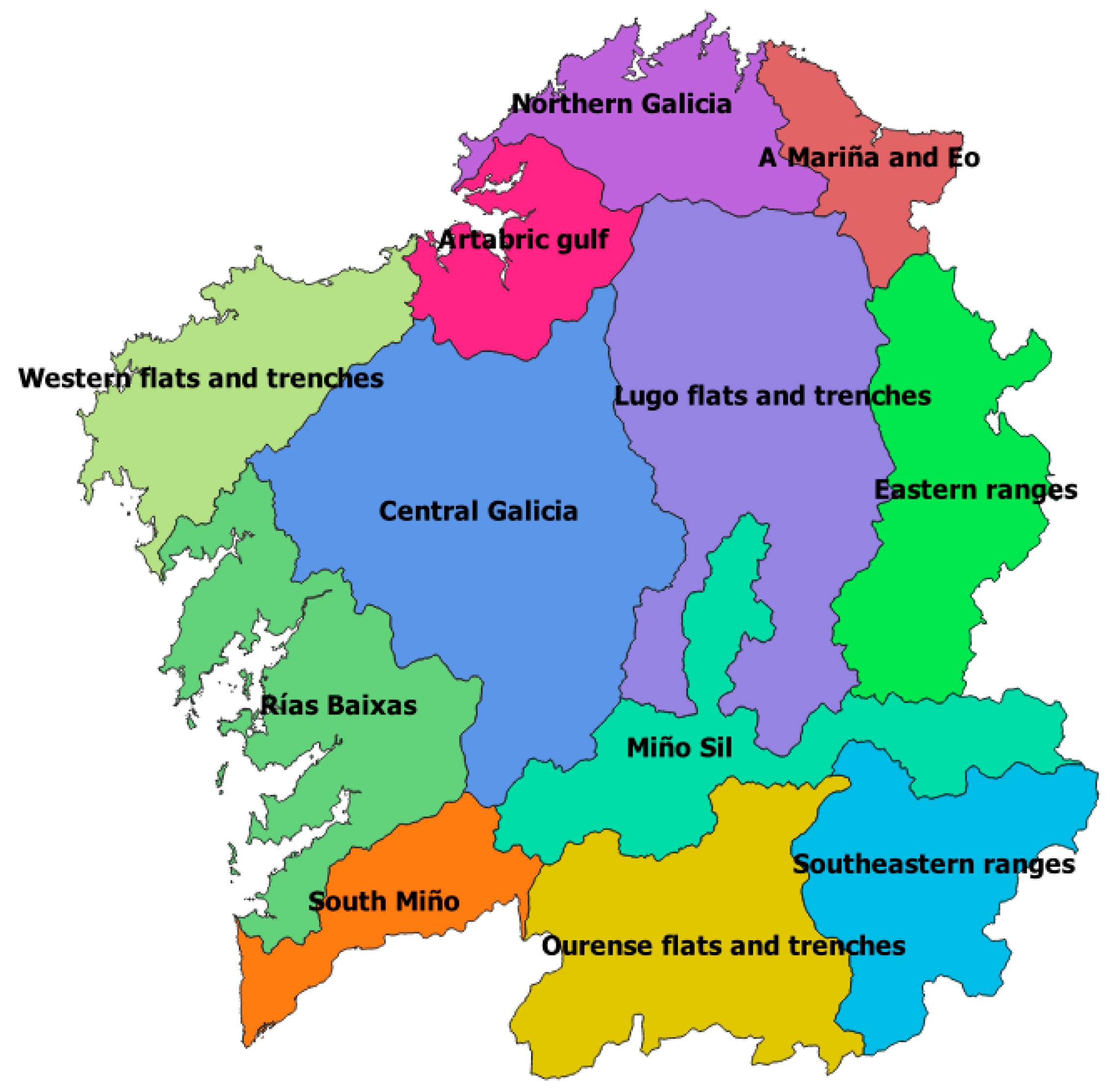1. Introduction
The IPCC predictions for climate change (CC) in Europe foresee hotter and drier summers and alterations in precipitation regimes, with an increase in the frequency of heavy storms and rainfall events [
1]. These changes will affect ecosystem dynamics and thus the composition of the species the ecosystems host. As a consequence, CC may exert negative impacts on biodiversity [
1], as recognized in the EU biodiversity strategy for 2030 [
2], which states that CC and biodiversity loss are intrinsically linked. Biodiversity and the provision of other ecosystem services (ESS) may, in turn, play an important role in preventing the negative effects of CC [
3]. In this line, the EU biodiversity strategy [
2] states that “nature is a vital ally in the fight against CC” and refers to nature based solutions and green infrastructure (GI) as key factors in mitigating the negative effects of CC. Consequently, the EU Commission communication “Green Infrastructure: Enhancing Europe’s Natural Capital” [
4], establishes the basis for the creation of GI in EU member states, in order to tackle biodiversity loss. This endeavor requires methodologies that can be applied at a regional scale to help policymakers and planners to delimit GI elements. In this paper, we will focus on the development of a methodology for delimiting GI aimed at helping to mitigate the negative effects of CC on biodiversity.
The concept of GI was first proposed by Rosenberg [
5], who considered urban parks an extension of the infrastructure of cities, providing functions in addition to recreation, such as storm water infiltration. The notion of GI has since evolved and many definitions have been proposed [
6]. The idea most frequently shared by these definitions is that GI is a network of green areas interconnected by several environmental functions at different scales, where natural processes work simultaneously to provide a greater environmental, social, and economic value [
7]. Nonetheless, this idea is interpreted in different ways in GI planning. Thus, we can find examples of GI that consider green spaces as natural areas, such as wetlands and forests [
8], as well as other examples that consider these spaces as grey infrastructure aimed at producing environmental benefits, such as fostering sustainable mobility or producing green energy [
9,
10]. In a similar way, depending on the interpretation, we can find examples of GI that focus on promoting environmental benefits [
11,
12], social functions [
13,
14], and fostering economic benefits [
15,
16]. The large number of definitions and interpretations provide an opportunity to find common ground to create an equilibrium between nature conservation and socioeconomic development [
7]. However, this also creates ambiguities that may disrupt this balance when GI are implemented in practice [
7].
As this study aimed to develop a methodology that EU member states can use to delimit the GI foreseen in the biodiversity strategy [
2] and mandated by the communication of the EU Commission on GI [
4], we will adopt the definition provided in aforementioned document: “GI is a strategically planned network of natural and semi-natural areas with other environmental features designed and managed to deliver a wide range of ESS”. According to this definition, development of the methodology will focus on delimiting multifunctional GI areas that will ensure the provision of several ESS that contribute to mitigating the impacts of CC on biodiversity.
As recognized by the EU Commission, GI can help to counteract the effects of CC by preventing floods, regulating hydrological flow, filtering pollutants, preventing erosion, and restoring connectivity to enable migration of species [
17]. These benefits have been confirmed in many scientific studies [
18,
19,
20] and can potentially prevent biodiversity loss due to CC [
2]. Consequently, GI is acquiring increasing importance in relation to CC adaptation [
21]. However, Matthews et al. [
22] warned that integration of GI in commonly used planning tools and processes is one of the main challenges to applying GI for CC adaptation. Therefore, GI should be conceived as a spatial concept [
23] and thus, spatial planning methods should be used for designing GI.
The basis for taking integrated spatial planning decisions to design a GI, is mapping the potential for providing ESS [
24,
25]. Several methods have been developed to map ESS provision potential [
26,
27]. The most commonly used methods consider land-cover maps as a proxy for ecosystems and consequently establish relationships between land cover and the ESS provision potential [
26]. ESS mapping from land-cover data is widely applied because the methods involved are simple to implement and use readily available data. However, methods based on land-cover mapping may not be accurate enough to estimate the provision potential of ESS that are influenced by landscape patterns [
28]. In this case, other methods that estimate the provision potential through more complex models are better suited, although they demand more data, which are often not available [
29].
ESS mapping enables planners to identify areas of land with the highest potential for providing ESS, as well as the types of land cover that are compatible with ESS provision and also the impact of change in land cover on the ESS provision potential. However, the outcomes of ESS analysis have not been widely used for the spatial planning of GI, as they are difficult to incorporate in the planning process due to the complex relationships between different ESS [
25,
30,
31]. In addition, most previous research in this area has focused on how GI contributes to CC adaptation in urban areas [
32,
33,
34,
35], where the ESS provided by green areas are more evident. At a larger scale, landscape patterns are more complex and may induce synergies and trade-offs [
28,
36,
37] that will increase the complexity of mapping ESS provision. This makes the process of incorporating ESS in planning procedures at this scale even more difficult.
On the other hand, the methods available for planning GI at regional scale mainly focus on locating corridors [
38] or on designing GI with specific objectives, in which particular ESS are taken into account; e.g., GI designed to regulate water cycles [
39]. Examples of regional-scale GI spatial planning methods that consider a wide range of ESS are scarce [
40] and we do not know of any that specifically concern ESS related to CC mitigation and/or adaptation. Most of the available methods are based on multi-criteria decision analysis [
41,
42] or consist of algorithms of heuristic optimization designed for different purposes and that are applied to delineate GI [
23,
43,
44].
Methods of multi-criteria decision analysis include that proposed by Liquete et al. [
42], which combines the provision potential of different ESS to identify GI areas for conservation (those with a high combined ESS provision potential) and GI areas for restoration (those with a moderate ESS provision potential). Kopperoinen et al. [
40] also combined maps of the provision potential of several ESS to identify GI multifunctional areas.
In addition to maximizing the provision potential of several ESS, heuristic methods can incorporate criteria for delimiting GI that cannot be considered in methods based on multi-criteria decision analysis. This applies to criteria such as the size and compactness of the delimited areas or their proximity to other elements of the GI. These methods can therefore delimit larger and more regular GI areas [
45] that reduce edge effects [
28] and have a greater potential to provide a wider variety of ESS [
37]. On the other hand, heuristic optimization methods require more computation time and specific knowledge for fitting the optimization criteria. In addition, they produce an average optimum for the criteria considered and therefore do not grant maximization of ESS provision potential in the areas delimited [
45]. The available heuristic methods that can be used for GI planning include spatial conservation prioritization techniques for planning natural spaces [
23,
44] and land cover optimization algorithms for land planning [
43]. In addition, the Marxan software was designed for reserve selection in conservation planning and has been used by Schröter and Remme [
45] to delineate ESS hotspots and by Vallecillo et al. [
44] to delineate GI areas under different scenarios considering several ESS.
None of the aforementioned methods delineate multifunctional GI areas that would provide a variety of ESS with a specific purpose, such as mitigating the impacts of CC on biodiversity and the population. Moreover, none of the methods delineate GI areas by considering how they will be integrated with other GI elements such as core areas and corridors. These two elements are key to developing a methodology for spatial planning of GI, as areas must be delimited according to their function and by taking into account how they complement other areas in zoning plans.
In the present study, we propose a methodology for delimiting multifunctional zones that will act as buffers to counteract the impacts of CC in core areas and corridors in GI. The method has been tested by applying it to GI zoning in the region of Galicia (NW Spain). With this aim, the ESS involved in CC mitigation and adaptation were identified and their provision potential was mapped for the whole region. A multi-criteria evaluation method was used to combine the resulting ESS provision potential maps to produce a suitability map for multifunctional areas. The cells with the highest suitability values were selected, and the largest highly suitable cell patches adjacent to core areas and corridors in the GI were then delineated as multifunctional buffer zones. The resulting zones were analyzed to check whether they meet the criteria of having a high potential for providing several ESS and serving as buffer zones to prevent the impacts of CC in core areas and corridors in the GI. The methodology successfully delimited multifunctional GI elements that can counteract the impacts of CC since results show that they have a high potential for providing more CC related ESS than GI corridors and core areas as well as zones outside the GI. The delimited areas were found to be rather irregular due to landscape heterogeneity in the region. Suggestions are made for ways of incorporating landscape structure for delineating GI, in order to produce more regular GI elements and thus increase ESS provision.
In the following sections, the study area is introduced together with the criteria that are followed to select the CC related ESS to map. Then, the methodologies that were used to map the provision potential of the selected ESS and to delimit the GI multifunctional buffer zones are presented. The obtained ESS provision potential maps and the delineated multifunctional buffer zones are analyzed in the results section. With this aim, zonal statistics were used to estimate which land covers have the highest ESS provision potential and whether the delineated GI multifunctional buffer zones have a ESS provision potential higher than other areas. Landscape statistics were also used to assess whether the delineated GI zones are compact and located close to the areas that demand the ESS they produce. Finally, the main conclusions from the results analysis are presented.
4. Conclusions
The proposed methodology successfully delimited multifunctional zones in GI with a high potential to provide ESS that contribute to counteracting the consequences of CC in areas with high biodiversity and natural values. The use of land cover as a proxy for mapping the ESS provision potential facilitates identification of the types of land cover with the highest potential to provide ecosystem services. Furthermore, combining several ESS provision potential maps in a suitability map to delimit GI not only ensures the GI multifunctionality, but also further aids identification of the types of land cover with the highest potential to provide several ESS.
However, application of the methodology in Galicia has shown that complex landscape patterns produce irregular GI areas and faces challenges in relation to delineating the minimum surface area. On the other hand, by identifying the types of land cover with a high potential to provide several ESS, planners can obtain an idea of how to fine-tune the results of the delimitation. Therefore, the boundaries of the delimited areas can be adjusted to include land cover types with high potential to provide ESS and exclude those with a lower potential, thus ensuring that the GI is close to areas where there is a demand for the ESS it produces.
Trade-offs between ecosystem services occur, and although an area may have a high potential to produce several ESS, it may also have a low potential to produce others. In this case, using land cover as a proxy may hamper the identification of areas with a high potential to provide several ESS. For example, although forests have a high potential to capture carbon, filter pollutants, and regulate hydrological cycle, they do not have high potential for fire prevention. Nevertheless, irregular and mixed landscapes of forests and fields may have a high potential to prevent fires while producing other ESS more closely linked to forests. In addition, landscape patterns can also create synergies or trade-offs among ESS and either increase or reduce their provision potential or increase the provision of ESS in areas close to zones of demand [
28,
36]. Qiu and Turner [
37] suggest delimiting areas that are large enough to comprise spatial heterogeneity and reduce trade-offs. Similarily, Walz et al. [
79] suggest that landscape units should be used to delimit GI multifunctional areas.
Bearing all of the above in mind, future methodologies should explore the potential of including landscape structure in ESS mapping, mainly in those cases where the ecosystem service is not clearly linked to a particular land cover type [
36]. In this regard, tier III methods, as defined in Maes et al. [
29] (which rely on a regression model to link data from a statistical survey with spatial variables), will be more efficient for analyzing the relationship between landscape pattern or landscape units and ecosystem service provision potential. However, these methodologies require input of large amounts of data.
Another possible way of improving methodologies for the spatial planning of GI is to delineate landscape units and identify those with the highest potential to provide several ESS. This would reduce the influence of landscape heterogeneity on the results of the GI zoning and thus produce more regular delimited areas.









